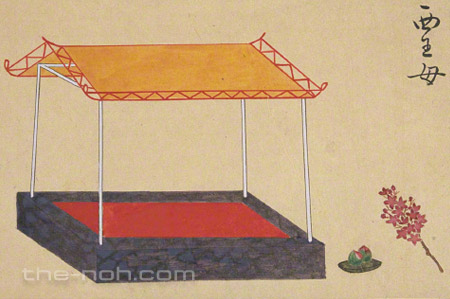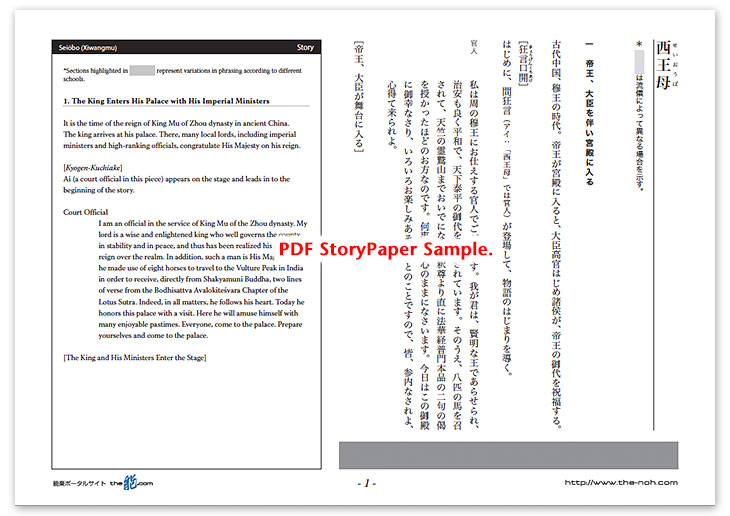
 Seiōbo (Xiwangmu)
Seiōbo (Xiwangmu)

![]()
The setting is ancient China, during the reign (976-922 BCE) of King Mu of the Zhou dynasty. When the king is entertaining himself in the palace at a party celebrating his reign, a young lady appears. She holds a branch of peach blossoms in her hand. She says that this peach, which blooms only once in three thousand years, is blooming now thanks to the dignity and virtue of the king. She then offers the branch to the king. The king asks the woman if the peach branch is from the legendary garden owned by the Queen Mother of the West, Xiwamgmu (in Japanese, Seiōbo 西王母). Without answering his question, she responds that “peach blossoms do not speak, passing many years in silence.” In order to laud the reign of the king, she also recites an old poem: “This is the year I encounter the spring, / When blossoms are put forth / By the peach that bears fruit / Only once in three thousand years.” Then she reveals that she is a transformation of the Queen Mother of the West and leaves for the heavens after promising the king to return in her true form and present him with the fruit of the peach.
The king has musicians perform while he awaits for the return of Xiwangmu, who appears in her celestial form. Her attendants are bearing peaches that she offers to the king. A joyful drinking party starts. While both people and flowers become tipsy and enjoy the festive mood, Xiwangmu dances airily. Congratulating the king on his reign, she rides the spring wind and ascends heavenward with peacocks and phoenixes, disappearing from sight.
![]()
This waki-Noh is based on an ancient Chinese myth about the Queen Mother of the West, Xiwangmu (Seiōbo in Japanese). The story develops around the peach groves in Xiwangmu’s garden, which flower and bear fruit once every three thousand years. The piece is embued with an auspicious, refreshing, and celebratory atmosphere.
The first and second halves both have impressive scenes that gently draw the audience into the ethereal world. In the first half, the chants depict the palace during a peaceful reign, after which a young lady appears on the stage, bringing with her the delicate fragrance of peaches. The story calmly proceeds in this fragrant atmosphere. In the second half, Xiwangmu appears on stage and dazzles against a gorgeous spring backdrop with peacocks and phoenixes flying around. She performs a dance from the celestial world that expresses the feeling of the kyokusui-no-en, the party by a meandering stream.
This play offers an escape from today’s world and the chance to enjoy the mythological world of an ancient Chinese legend, which is certainly one of the major attractions of Noh dramas.
STORY PAPER : Seiōbo (Xiwangmu)
Story Paper presents noh chant stories in modern speech, with story outlines, highlights and more using Adobe PDF format, which can print out and zoom in. Print out the pages and take them with you when you see the actual noh performance.

The copyright of Story Paper is held by the Noh.com. Story Paper is for individual use only. It is prohibited by the copyright law to distribute or publish printed-out Story Paper pages without prior consent. For more information, check the credit and disclaimer pages.



 [Seiōbo (Xiwangmu) : Story Paper PDF : 467KB
[Seiōbo (Xiwangmu) : Story Paper PDF : 467KB